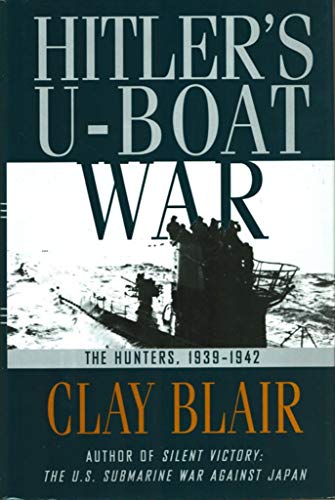Hitler's U-Boat War : The Hunters, 1939-1942 (Hitler's U Boat War)
Blair, Clay
About the Book
Description:
SHIPS FROM USA. Used books have different signs of use and do not include supplemental materials such as CDs, Dvds, Access Codes, charts or any other extra material. All used books might have various degrees of writing, highliting and wear and tear and possibly be an ex-library with the usual stickers and stamps. Dust Jackets are not guaranteed and when still present, they will have various degrees of tear and damage. All images are Stock Photos, not of the actual item. Seller Inventory # 3-0394588398-G
About this title:
Synopsis: Clay Blair's best-selling naval classic Silent Victory: The U.S. Submarine War Against Japan, is regarded as the definitive account of that decisive phase of the war in the Pacific. Nine years in the making, Hitler's U-boat War is destined to become the definitive account of the German submarine war against the Allies, or "The Battle of the Atlantic."
It is an epic sea story, the most arduous and prolonged naval battle in all history. For a period of nearly six years, the German U-boat force attempted to blockade and isolate the British Isles, in hopes of forcing the British out of the war, thereby thwarting the Allied strategic air assault on German cities as well as Overlord, the Allied invasion of Occupied France. Fortunately for the Allies, the U-boat force failed to achieve either of these objectives, but in the attempt they sank 2,800 Allied merchant ships, while the Allies sank nearly 800 U-boats. On both sides, tens of thousands of sailors perished.
The top secret Allied penetration of German naval codes, and, conversely, the top secret German penetration of Allied naval codes played important roles in the Atlantic naval battle. In order to safeguard the secrets of codebreaking in the postwar years, London and Washington agreed to withhold all official codebreaking and U-boat records. Thus for decade upon decade an authoritative and definitive history of the Battle of the Atlantic could not be attempted. The accounts that did appear were incomplete and full of errors of fact and false interpretations and conclusions, often leaving the entirely wrong impression that the German U-boats came within a whisker of defeating the Allies, a myth that persists.
When London and Washington finally began to release the official records in the 1980s, Clay Blair and his wife, Joan, commenced work on this history in Washington, London, and Germany. They relied on the official records as well as the work of German, British, American, and Canadian naval scholars who published studies of bits and pieces of the story. The end result is this magnificent and monumental work, crammed with vivid and dramatic scenes of naval actions and dispassionate but startling new revelations and interpretations and conclusions about all aspects of the Battle of the Atlantic.
The Blair history will be published in two volumes. This first volume, The Hunters, covers the first three years of the war, August 1939 to August 1942. Told chronologically, it is subdivided into two major sections, the War Against the British Empire, and the War Against the Americas. Volume II, The Hunted, to follow a year later, will cover the last years of the naval war in Europe, August 1942 to May 1945, when the Allies finally overcame the U-boat threat.
Never before has Hitler's U-boat war been chronicled with such authority, fidelity, objectivity, and detail. Nothing is omitted. Even those who fought the Battle of the Atlantic will find no end of surprises. Later generations will benefit by having at hand an account of this important phase of World War II, free of bias and mythology.
Review: A former infantryman, Adolf Hitler had little use for the German navy, which he considered inept and politically suspect. Still, through the skillful maneuverings of a young, up-and-coming naval officer named Karl Dönitz, Hitler eventually endorsed a costly program of shipbuilding. As a result, Dönitz was able to field a vast fleet of U-boats when Germany went to war against France and England in 1939. Although his enemies were initially better equipped, Dönitz was the craftier fighter, launching daring raids on shipping convoys and Allied harbors, and for a time, controlling the chief Atlantic sealanes.
In this monumental history, Clay Blair analyzes the German U-boat campaigns from 1939 to 1942 (a companion volume continues his narrative to 1945), which, he writes, fall into three phases: one against England alone, another against the newly arrived American navy, and a furious third against the combined Allied forces. Blair argues, against other historians, that the "U-boat peril" has been overestimated. He holds that the American submarine campaign against Japan in the Pacific was far more effective, and observes that 99 percent of Allied merchant ships on transatlantic convoys reached their destinations. Even so, the U-boats introduced a powerful element of terror into an already horrific war, diverting Allied effort into antisubmarine campaigns and delaying the transport of much-needed materiel.
Blair's outstanding work adds much to the naval history of World War II. Packed with detail, it is sure to become a standard work on the Battle of the Atlantic. --Gregory McNamee
Bibliographic Details
Title: Hitler's U-Boat War : The Hunters, 1939-1942...
Publisher: Random House
Publication Date: 1996
Binding: Hardcover
Condition: Good
Book Type: book
